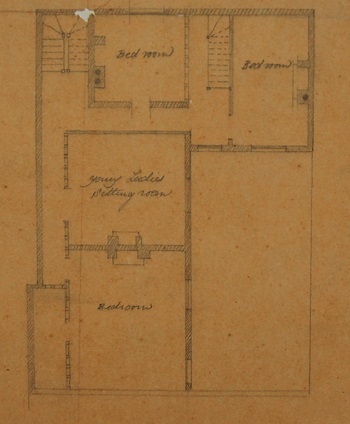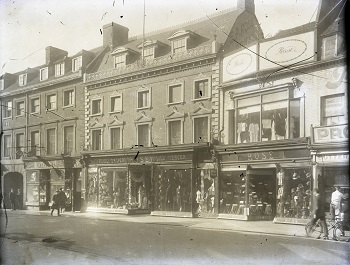E P Rose & Son
In 1838 Thomas Smith Rose purchased the drapery business of Thomas Langley at 51 High Street, Bedford. Thomas was not a native of Bedford, his father, also called Thomas, was from Fenstanton and Thomas the younger had been baptised at Haddenhan, Huntingdonshire in 1814. On the 1st March 1840 young Thomas married Emma Paine of Gamlingay and their son, Edward Paine Rose, was born above the shop at 51 High Street on the 29 December 1840. Sadly Emma died shortly after Edward’s birth. In spite of the personal tragedy 27 year-old Thomas seems to have been doing quite well in business as on the 1841 census his household consists of himself, his younger brother Holland, three apprentices and a female servant; baby Edward is with a family in Gamlingay. In 1846 Thomas married again. His bride was Mary Green, the daughter of Thomas Green of Bedford. Thomas and Mary soon have two children, Thomas Harry and Lydia Susan.
By the 1851 census Thomas appears to have moved across the street to number 50 where his household consists of: himself, Mary, his three children, his brother, one assistant, one apprentice and two female servants. Thomas and Mary go on to have two more children - John Holland and Fanny. All seems to be going well. By 1861 Edward is a draper’s apprentice in Birmingham, presumably with the thought that he would join or inherit his father’s business. This inheritance was to arrive quite soon as Thomas died on the 6 January 1863. Edward took over the business and managed it in partnership with his step-mother. In July 1864 Edward had plans drawn up by John Usher for alterations to No 50 High Street (BorBP6). The Plans include the redevelopment of the living quarters to the rear of the shop and may have been in response to Edward’s marriage to Emma Goode the same year.

Extract from plans of alterations to Messrs. Rose, 50 High Street, 1864 [ref: BorBP6]
A son, Thomas Edward, was born to Edward and Emma in 1865. In spring 1867 the family moved away from the shop to 16 St Cuthbert’s Street and a daughter, Agnes Emma, was born. Tragedy struck the family when Agnes died at three months old and Emma died two days after Agnes. By now neither Edward nor his step mother lived above the shop as Mary lives at St Peter’s Green. Edward remarries in 1870. His young bride is Fanny Atcherley of Manchester. It is likely that business and religion played a part in bringing Edward and Fanny together. Fanny’s father was a partner in a linen drapers and silk merchants and both Fanny and Edward were non-conformists who knew John Brown, former minister at Park Chapel Manchester (where Edward and Fanny were married) and, at the time of their marriage, co-pastor of the Bunyan chapel in Bedford where Edward was an active member of the congregation.
In 1871 Edward is described as a draper employing 42 people. His stepmother is also described as a draper and his half-brother, Thomas Harry, is employed as a draper. In 1878 Edward applies to make alterations to the premises in order to create a carpet room out of the yard. From this plan [ref: BorBP634] we can see that what had once been the drawing room is now the counting house and the dining room is now the kitchen and the kitchen now the pantry. There were objections to the plan as the reduction in the yard meant that the air space did not meet the Borough’s byelaws.

Ground plan extract of plan of alterations to 50 High Street, 1878 [ref: BorBP634]
The business continued to grow and by 1881 Edward is employing 40 assistants, 48 day rate and three porters. Mary has retired from the business and Thomas Harry is running his own business in Gravesend, Kent; Edward’s 16 yearold son, Thomas Edward, is still at school. By 1891 Thomas Edward has joined the business and the firm is E P Rose & Son. Beyond the drapery the Rose family made their mark. Thomas Smith Rose was a member of Bedford Town Council and the Harpur Trust, his son Thomas Harry moved from Gravesend to Oxford where he became governing director of Elliston and Cavell Limited and William Baker and Co Limited and a Justice of the Peace. John Holland Rose became a Doctor of Literature, historian and author, while Fanny married Mr Haddon a reader in Ethnology at Cambridge University. Edward Paine Rose’s younger children also did well: Edward Barkley became an engineer; Frank Atcheley a surgeon specialising in diseases of the throat; John Leonard, known as Leonard, became a chemical manufacturer. Edward’s youngest child, Isobel Gwendoline (known as Gwen) died in 1910 aged only 26. Gwen had studied at Girton college and had been treasurer of the Bedford High School Guild.
The success of Edward and Fanny’s children probably had much to do with Fanny’s interest in education and nursing. When Fanny died in 1908 the obituary in the local paper described her as an ‘amiable and estimable lady…keenly and practically interested in charitable work, and movements for the amelioration of the sick and suffering…Mrs. Rose frequently attended the sewing and general meetings of the Bedford Women’s Liberal Association, and helped gladly in the educational work. … Her interest in intellectual movements was shown by her support for several years of the University Extension lectures in the town, and Mrs. Rose herself was a regular attendant. To the Work of the Charity Organisation Society Mrs. Rose gave her close attention, and she was also a member of the House Committee of the Bedford District Nursing Association…Her activities were manifest in useful channels, her advice was very helpful, and her service was always cheerfully given.’

Postcard sent 10 July 1905 showing E P Rose’s shop at number 50 –52 High Street. The company had only recently extended into number 52, which in 1904 had still been occupied by Thomas Coombes. [ref: Z1306/10/33/72]
In 1896 the company applied to build a house and stables in De Parys Avenue (BorBP3189). Edward Paine Rose died at his home 45 De Parys Avenue on the 10 July 1911. Announcing his death, the Bedfordshire Times reported that he had been in delicate health for some time with lung and heart trouble but had recently been out for a drive with his son visiting the homes of previous generations at St Ives, Fenstanton and Gamglingay. Edward was described as a music lover who was an old member of the Bedford Musical Society and a very good friend to the Bedford Silver Prize Band. ’His faculty for giving attention to detail in business and other matters was illustrated by the interest that he took in the railway time-tables and the postal arrangements, and he at times took steps to call attention to deficiencies which were usually rectified. Improvements in the railway service to London were sometimes due to Mr. Rose’s suggestions. In public life he was never a strong partisan, but was perhaps rather disposed to be critical of the more impetuous spirits.’ (Beds Times 14 July 1911)
Edward’s will made provision for his son Thomas Edward Rose to take over his interest in the business at a valuation. In 1913 the business became a limited company with Thomas Edward Rose and his wife Lydia Boden Rose as the two named subscribers [ref: X679/10/2]. Thomas Edward died on the 9th July 1914. The Bedfordshire Times suggested that he had been ill for some time with heart trouble. The obituary described how ‘He took a keen and enthusiastic interest in his work, and until quite recently retained a close control of its management’. Like his father before him he was a member of the Bunyan Meeting but rather than music it was Thomas’ interest in the Bedford General Library and Literary and Scientific Institute that receives particular mention. Thomas Edward and Lydia had only had two daughters. Dorothy Nesta, the elder of the two, had died in 1911 aged 19 and Winifred Isobel (known as Freda) died in 1918 aged only 24. By 1922 shares in E P Rose & Son were divided between members of the extended Rose family.
 A 1920s view showing left to right: the arch to the Old George Yard, Anthony & Son chemist at 48, E P Rose at numbers 50 and 52 and the edge of Johnson & Co’s Premier Stores [ref: BTNegM1-2]
A 1920s view showing left to right: the arch to the Old George Yard, Anthony & Son chemist at 48, E P Rose at numbers 50 and 52 and the edge of Johnson & Co’s Premier Stores [ref: BTNegM1-2]